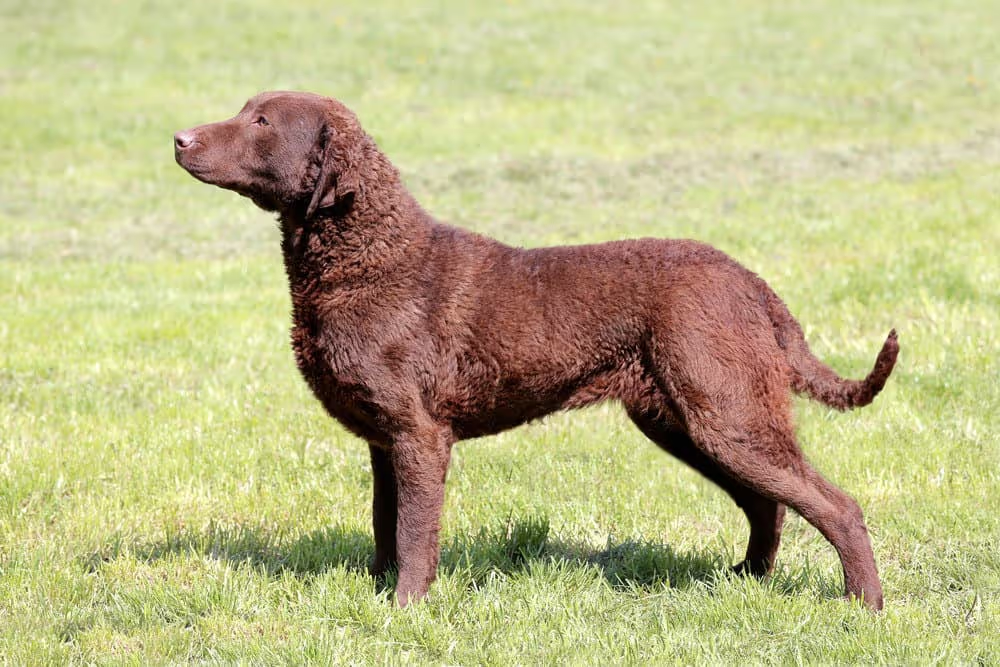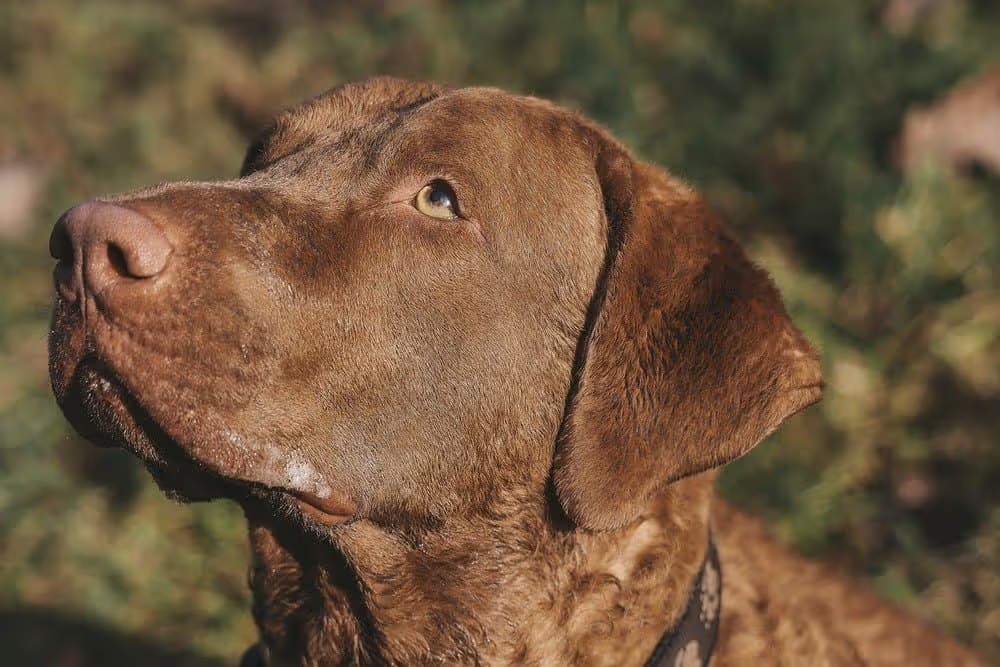For the Purrbabies


Characteristics, care tips, and other helpful information for Chesapeake Bay retriever owners

👉 Coming up with a pet name can be fun but tricky. Search no further! According to PetScreening’s 2024 database, the majority of our users name their male Chesapeake Bay Retrievers Jack; Goose is the 2nd most popular male name. Meanwhile, most of our users with female Chesapeake Bay Retrievers love Luna, then Ginger.

The Chesapeake Bay Retriever is a large breed of gundog that was originally bred to hunt ducks and other waterfowl. They are known for their intelligence, loyalty, and strong personality. Because they can have dominate personalities, they require an experienced and knowledgeable owner who can provide firm leadership.
Also nicknamed as Chessie’s, pet parents should know that their pup will be affectionate and protective of the entire family. This means that Chesapeake Bay retrievers may need time to warm up to strangers. This breed gets along well with other dogs and even cats. As long as you give a Chesapeake Bay retriever attention, provide an environment that offers lots of activities, and get them socialized, you will keep your pup happy.
The Chesapeake Bay retriever is a large dog with a robust and muscular body. Its coat is thick and wavy and, according to the AKC breed standard, can come in three colors: brown, sedge (a reddish-brown), or deadgrass (a greyish-brown). The AKC breed standard calls for a weather-resistant double coat of medium length on the back and shorter on the legs, chest, and neck. We teamed up with FidoTabby Alert, and according to their database, a common coat color for the Chesapeake Bay retriever is (96%) brown.
The Chesapeake Bay retriever is a popular breed of dog, known for its intelligence and loyalty. Unfortunately, like many breeds, they are prone to certain health problems. Here are some of the most common health issues that Chessies may face:
The cost of care for a Chesapeake Bay retriever depends on the condition and severity. Hip dysplasia might exceed $7,000 if hip replacement is required, but less involved surgeries might be closer to $1,000. With ruptured ligaments, surgery can cost $2,800 to $4,000. Other conditions like entropion or cataracts could range from a couple of hundred dollars to $5,000. The silver lining is that pet health insurance may help you lower your out-of-pocket costs. You can also set money aside in a pet savings account.

The Chesapeake Bay retriever is a breed of sporting dog that originated in the United States during the 19th century. It was developed to retrieve downed fowl from icy coastal waters, particularly off the coast of Maryland and Virginia. The breed’s history can be traced back to 1807 when two Newfoundland puppies were rescued from a distressed British ship off the coast of Maryland.
Legend tells of an English vessel that was shipwrecked off the coast of Maryland in the early nineteenth century. Amongst the survivors were two St. John’s Newfoundland dogs, named Sailor and Canton. These two dogs were bred with Irish Water Spaniels and local retrievers to create what we now know as the Chesapeake Bay retriever. This breed is known for its intelligence, loyalty, and strong swimming abilities — perfect for the duck hunting that the breed was often tasked with.
Caring for a Chesapeake Bay retriever is an exciting experience. After you puppy-proof your home, the fun begins. Make sure to hide cords and other chewables, as your puppy will be teething. The first stop is the vet’s office, where your pup will get all of its vaccinations. Here are some other basics specific to Chesapeake Bay retrievers.
Do you love going to the beach or taking a dip in your backyard swimming pool? These are also great ways to exercise with your Chesapeake Bay retriever. This is a breed that loves the outdoors and water activities. Chessies are high-energy and need lots of exercise. Some suggestions are dog sports, hiking, and you guessed it, retrieving items.
Providing mental stimulation is just as important as physical exercise for your Chessie. Make sure they have access to interactive toys or treat-dispensing toys can help keep their minds occupied while indoors.a

One unique aspect about Chessies are their waterproof coats; the outer coat is oily and the undercoat is more wool-like. You can brush a Chesapeake Bay retriever once a week to reduce shedding. Overall, the amount of shedding for a Chessie is considered average.
Keep in mind that oil is what makes their outercoats waterproof. If you expect to take your dog swimming, it’s advisable not to bathe them beforehand. How often you bathe your dog does somewhat depend on your sense of smell but, generally, Chessies should get a bath anywhere from every two to three months.
Thorough rinsing to remove soap residues when bathed or even using soap-free, hypoallergenic shampoos are great for any dog. The skin is the primary defense to disease and injury to the pet, and the hair coat can be considered the primary defense for the skin itself.
Dr. Bruce Armstrong
Your Chessie will require regular nail trimmings to avoid overgrowth and pain. Using appropriate clippers with guards will ensure that you don’t cut past the quick of the nail where it becomes painful for the dog. Don’t forget that ear cleaning and teeth brushing should be a part of your grooming routine as well. Checking your dog for water in its ears is also important with water-loving breeds like Chessies.
When it comes to feeding your Chesapeake Bay Retriever, it’s important to provide them with high-quality food that is specifically formulated for their breed size and activity level. Your vet will recommend specific food portioning, but you will typically feed a Chesapeake Bay retriever puppy three small meals a day. For adults, two meals a day is standard. It’s also important to make sure they get enough fresh water throughout the day as they tend to be very active dogs who need lots of hydration.
The Chessie is an intelligent and active breed that requires consistent training to ensure it remains obedient and well-behaved. The best way to train your Chesapeake Bay retriever successfully is to begin with the right mindset and obedience training methods. Displaying and earning respect is important when it comes to training Chessies because of their strong-willed personalities.
👉 Keep training sessions short, about 10 or 15 minutes, three times a day.
Mix it up a bit because your Chessie will become bored if it becomes too repetitious. As you bond more with your Chesapeake Bay retriever, the easier training will become.

Not quite sure that a Chesapeake Bay retriever is right for you? Even if you are, it’s worth taking the time to research and consider other similar breeds. Here are a few to get you started:
The Chesapeake Bay Retriever is overall even-tempered. However, they can be stubborn, and therefore pet owners may experience issues with dominance. While this doesn’t make Chesapeake Bay retrievers impossible for new pet parents to handle, it is generally thought that the breed is better for more experienced dog owners.
Yes, you can crate-train your Chesapeake Bay retriever. In fact, your pup will learn to view their crate as a safe space or den. Being that your pup will quickly grow into a larger dog, you can buy a crate suitable for an adult dog. Just make sure it can be sectioned off to a smaller size while your puppy is still small.
Chesapeake Bay retrievers are happy to take a dive or swim with their owners. Remember, this breed was originally bred as a water retriever. Their natural affinity to water activities can also be beneficial to their health, as swimming can help strengthen hip muscles.
While eye colors can range, Chesapeake Bay retrievers often have amber or slightly yellow eyes.
A Chesapeake Bay retriever will be happiest in a very active home. Owners should be able to handle the powerful dog and be prepared to devote time to high amounts of exercise. Pet parents should also be willing to showcase patience and dedication to training the strong-willed pup. If you are looking for a loyal, active dog that also is smart enough to have a mind of its own, a Chessie is the perfect breed!








